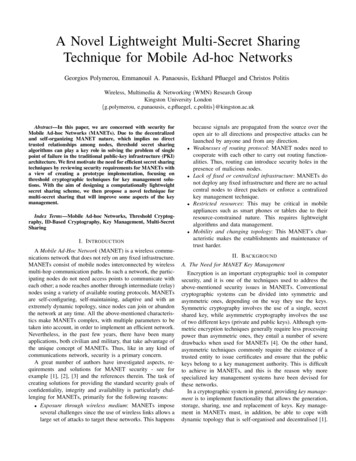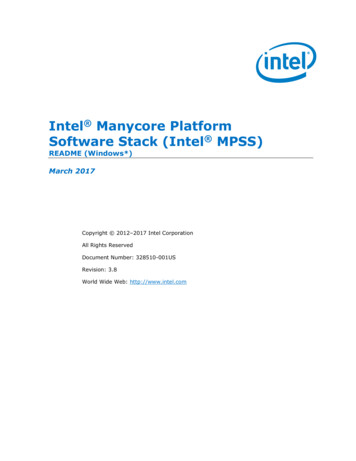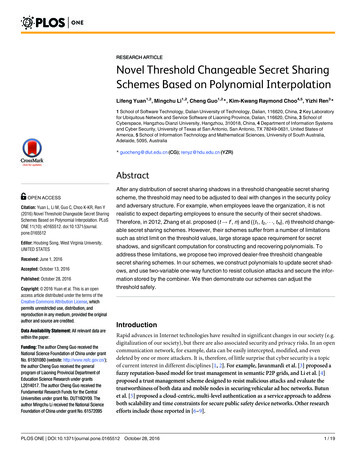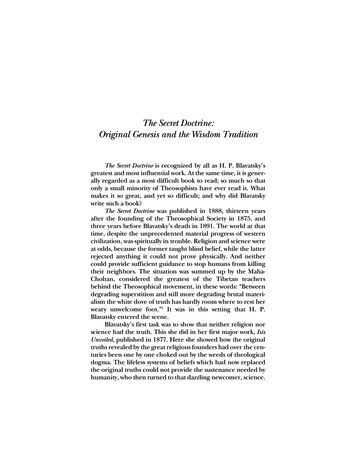
Transcription
MPSS: Mobile Proactive Secret SharingDAVID SCHULTZ and BARBARA LISKOVMassachusetts Institute of TechnologyandMOSES LISKOVThe MITRE CorporationThis article describes MPSS, a new way to do proactive secret sharing. MPSS provides mobility:The group of nodes holding the shares of the secret can change at each resharing, which is essentialin a long-lived system. MPSS additionally allows the number of tolerated faulty shareholders tochange when the secret is moved so that the system can tolerate more (or fewer) corruptions; thisallows reconfiguration on-the-fly to accommodate changes in the environment.MPSS includes an efficient protocol that is intended to be used in practice. The protocol isoptimized for the common case of no or few failures, but degradation when there are more failuresis modest. MPSS contains a step in which nodes accuse proposals made by other nodes; we showa novel way to handle these accusations when their verity cannot be known. We also present away to produce accusations that can be verified without releasing keys of other nodes; verifiableaccusations improve the performance of MPSS, and are a useful primitive independent of MPSS.Categories and Subject Descriptors: C.2.4 [Computer Communication Networks]: DistributedSystems—Distributed applicationsGeneral Terms: SecurityACM Reference Format:Schultz, D., Liskov, B., and Liskov, M. 2010. MPSS: Mobile proactive secret sharing. ACM Trans.Inf. Syst. Secur. 13, 4, Article 34 (December 2010), 32 pages. DOI /1880022.1880028.1. INTRODUCTIONMalicious attacks are an increasing problem in distributed systems. If a nodeholds an important secret, that secret could be exposed by an attack in whichan intruder gains control of that machine. An example of such a secret isThis research is supported by NSF ITR grant CNS-0428107.Authors’ addresses: D. Schultz (corresponding author) and B. Liskov, Department of ElectricalEngineering and Computer Science, Massachusetts Institute of Technology, 77 MassachusettsAvenue, Cambridge, MA 02139-4307; email: das@csail.mit.edu; M. Liskov, The Mitre Corporation, 202 Burlington Road, Bedford, MA 01730-1420.Permission to make digital or hard copies part or all of this work for personal or classroom use isgranted without fee provided that copies are not made or distributed for profit or commercial advantage and that copies show this notice on the first page or initial screen of a display along withthe full citation. Copyrights for components of this work owned by others than ACM must be honored. Abstracting with credit is permitted. To copy otherwise, to republish, to post on servers, toredistribute to lists, or to use any component of this work in other works requires prior specific permission and/or a fee. Permissions may be requested from the Publications Dept., ACM, Inc., 2 PennPlaza, Suite 701, New York, NY 10121-0701 USA, fax 1 (212) 869-0481, or permissions@acm.org.c 2010 ACM 1094-9224/2010/12-ART34 10.00 DOI: 10.1145/1880022.1880028. http://doi.acm.org/10.1145/1880022.1880028.ACM Transactions on Information and System Security, Vol. 13, No. 4, Article 34, Pub. date: December 2010.34
34: 2·D. Schultz et al.the private key used by a certificate authority (such as VeriSign) to sign itscertificates.A secret can be protected by secret sharing. Secret sharing schemes [Blakley1979; Shamir 1979] allow a collection of servers to possess shares of a secretvalue, such that any t 1 servers can collaborate to perform operations usingthe secret, but any t or fewer servers can learn nothing about the secret.In a long-lived system, however, nodes can become compromised over time,giving an adversary the opportunity to collect more than t shares and recoverthe secret. Proactive Secret Sharing (PSS) schemes [Cachin et al. 2002; Frankelet al. 1997; Herzberg et al. 1995; Ostrovsky and Yung 1991; Rabin 1998; Zhouet al. 2005] address this problem by using a share regeneration protocol, inwhich a new set of shares of the same secret is generated and the old sharesare discarded, rendering useless any collection of t or fewer old shares the adversary may have learned.Some PSS schemes reshare the secret among members of the same group.This approach is not sufficient in practice: it assumes a world in which serversthat fail are later recovered, but recovery of compromised nodes is problematic.The problem is that resharing schemes use ordinary secret keys to implementsecure channels, which are needed to reshare the secret. If the attacker learnsthese keys or corrupts them while the node is compromised, we cannot usethem to communicate securely in the future.This article describes a new resharing protocol called MPSS (for MobileProactive Secret Sharing) that addresses this problem by allowing the membership of the group to change. The servers that hold the secret shares periodically execute a handoff protocol that produces a new set of shares for a different(and possibly disjoint) set of servers. We present a novel way to accomplish thistransfer that works in an asynchronous network. MPSS protects the secreteven when up to t servers in the old group and t servers in the new group arefaulty. The number of shareholders in MPSS is n 3t 1, which is optimal foran asynchronous protocol [Bracha and Toueg 1985].Additionally, MPSS allows the threshold t to change. This is desirable because the threshold has a meaning: it represents an assumption about howeasily nodes can be corrupted. If current events (e.g., a newly discovered vulnerability in Windows) dictate a reevaluation of this assumption, it is betterto change the threshold than to start over. To our knowledge ours is the firstscheme for changing the threshold that works even when there is up to thethreshold number of failures in both the old and new groups.The MPSS protocol is intended to be efficient for values of t that might occurin practice; analysis shows that the expected range is 1–10 (see Section 3.4).The protocol is designed to minimize latency and bandwidth utilization forthe normal case, when fewer than t failures occur, for example, 0 or 1. However, even when there are as many as t failures, performance degradation isn’tsevere.Furthermore, our protocol uses an interesting technique for efficient handling of “accusation” messages that may either be true (if sent by an honestnode) or false (if sent by a liar), when there is no way to tell which of the accusing and accused nodes is faulty. We also describe an alternative approach inACM Transactions on Information and System Security, Vol. 13, No. 4, Article 34, Pub. date: December 2010.
MPSS: Mobile Proactive Secret Sharing·34: 3which the validity of such messages can be evaluated; this approach requiresthe use of identity-based, forward-secure encryption as discussed further inSection 5, but allows a more efficient protocol.The main contributions of this article are the following: (1) the introductionof an efficient, asynchronous protocol to reshare a secret to a new group ofshareholders; (2) extensions to that protocol to support changing the threshold;and (3) an efficient way of handling verifiable accusations, which are usefulfor building Byzantine-fault-tolerant systems. In the course of describing theprotocol, we show how techniques from several earlier works [Canetti et al.2003; Castro and Liskov 2002; Herzberg et al. 1995] can be combined in novelways to achieve our security and performance goals.The article is organized as follows. We begin by discussing related work.Section 3 describes the network model and assumptions, and also discussespragmatic issues such as determining how frequently to reshare the secret.Sections 4 and 5 describe our resharing scheme and the MPSS protocol, respectively, and Section 6 explains how to change the threshold. We present adiscussion of performance in Section 7 and conclude in Section 8. The appendices contain additional material, including informal correctness arguments.2. RELATED WORKSecret sharing was first proposed by Shamir [1979] and Blakley [1979]. Subsequent work by Feldman [1987] and Pedersen [1991] extended Shamir’s schemeto allow shareholders to determine whether the dealer sent them valid shares,hence allowing them to come to a consensus regarding whether the secret wasshared successfully.Proactive secret sharing schemes [Frankel et al. 1997; Herzberg et al. 1995,1997; Ostrovsky and Yung 1991; Rabin 1998; Zhou et al. 2005] attempt toaddress the problem that shares learned by the adversary are compromisedforever by resharing the secret periodically among the same nodes. Proactivesecret sharing was first proposed by Ostrovsky and Yung [1991] and shown tobe practical in a synchronous network model by Herzberg et al. [1995].Desmedt and Jajodia [1997] were the first to study redistribution of a secretto a new group. Their work assumes a synchronous network model and islimited because shares are not verifiable; a faulty node in the old group maycause the receiving group to get bad shares. Wong et al. [2002] extend thescheme of Desmedt and Jajodia to be robust against corrupted nodes in the oldgroup and provide verifiable shares. However, they require that all nodes in thenew group are nonfaulty, and their protocol takes exponentially many attemptsto complete in the worst case.The protocol of Cachin et al. [2002] is the first efficient PSS scheme designedfor the asynchronous model. Whereas the Herzberg scheme computes each newshare as a function of a corresponding old share, the Cachin scheme is basedon resharing the shares of the secret and combining the resulting subshares toform new shares of the secret. This scheme may allow the group membershipto change, but this issue is not addressed in Cachin et al. [2002]. Also, theyrely upon a collection of subprotocols, including a robust threshold signatureACM Transactions on Information and System Security, Vol. 13, No. 4, Article 34, Pub. date: December 2010.
34: 4·D. Schultz et al.scheme and a threshold coin toss protocol which are themselves challenging toimplement efficiently.The scheme of Zhou et al. [2005] is intended to allow the group to move.However, since their construction produces secret shares that are exponentiallylarge in n, the number of shareholders, the communication required to refreshthe secret is exponential. The approach works well for small t, for example, fort 1 or t 2. For example, the communication overhead of an implementationof this scheme [Chen 2004] is 47KB for t 1, 3.4MB for t 2, and 220MB fort 3.Our approach builds on the work of Herzberg et al. [1995], but they assumethe group membership is fixed and we allow it to change. Also, we assume amuch weaker (asynchronous) network. Our protocol makes use of accusationsas part of choosing the new shares, as does Herzberg et al. However, theirapproach assumes that lack of response implies the sender is faulty; this assumption doesn’t work in an asynchronous setting. We show how to overcomethis difficulty, both with and without verifiable accusations, and still ensurethat honest servers can eventually get their shares.Various generalizations of secret sharing have been proposed, for example, assigning differing weights to shareholders if some are presumed to bemore trustworthy than others [Ito et al. 1987; Shamir 1979], or using separate thresholds for liveness and safety [Cachin et al. 2002]. Although manyof the proposed techniques are applicable to MPSS, we do not discuss themhere in order to clearly present the features that we believe are most useful inpractice.3. MODEL AND ASSUMPTIONSIn this section we discuss how we model the network and the power of the adversary, as well as the cryptographic assumptions our protocols require. Briefly,we assume that the network is asynchronous and under the control of the adversary. The adversary may adaptively corrupt a limited number of nodes overa period of time, thereby learning all of their stored information and causingthem to behave arbitrarily badly.We assume a system in which each node (or server) has a public signing keyand also a public encryption key; the secret keys associated with these public keys are known only to the node. Each node also has a unique nonzeroidentifier. The correspondence between node ids and public keys is known byall nodes, for example, a node’s id might is a cryptographic hash of its publickeys; this precludes Byzantine nodes from successfully forging node ids. Thisinformation is propagated by some mechanism independent of MPSS, for example, by a Byzantine-fault-tolerant membership service [Cowling et al. 2009;Rodrigues et al. 2007].3.1 Epochs and Limitation of CorruptionsSystem execution consists of a sequence of epochs, each of which has an associated epoch number. In any given epoch e, a particular group of n nodes inACM Transactions on Information and System Security, Vol. 13, No. 4, Article 34, Pub. date: December 2010.
MPSS: Mobile Proactive Secret Sharing·34: 5the system is responsible for holding the shares of the secret. At the end of theepoch, the secret is transferred from these nodes (“the old group”) to a new setof nodes (“the new group”) and the system moves to the next epoch.The adversary is assumed to be active and adaptive: it may decide to corruptnodes at any point. We assume that the adversary can corrupt no more thana threshold t of the nodes in a group holding the secret in epoch e before theend of that epoch. Additional nodes may be corrupted after they have left theepoch. Because absolute clocks are not compatible with an asynchronous network, epochs are defined locally rather than as a global time period; the detailsare in Section 5.1.When a node becomes corrupted, its internal state is revealed to the adversary and it can behave arbitrarily: it is no longer constrained to follow theprotocol. We assume that corrupted nodes remain corrupted forever. This isreasonable because once the adversary knows a node’s secret keys, it would beunsafe to consider that node recovered without changing its keys, in which caseit would effectively be a different node.3.2 Network AssumptionsNodes communicate over a network by sending messages to one another; weassume messages are point-to-point: there is no broadcast channel. The network is asynchronous and unreliable: messages may be lost or delivered out oforder, and messages may appear that were not sent by any party in the system.This model reflects the realities of many wide-scale networks such as the Internet. To capture the worst possible network behavior, we assume an intelligentadversary controls all communication: it receives all messages, and determineswhat messages are to be delivered, and in what order.For termination, but not safety, we require a bound on message delivery. Inparticular, we assume strong eventual delivery.—Strong eventual delivery. Assuming a sender keeps retransmitting a message, that message will eventually be delivered with a maximum delaybounded by an unknown variable that does not increase exponentially indefinitely.This delivery assumption is the one used by Castro and Liskov [2002]. Anyproactive secret sharing protocol needs to assume bounded eventual deliveryin some form, to guarantee that epochs fit within a bounded time period.3.3 Cryptographic AssumptionsThe resharing protocol requires secure communication channels which we implement using cryptography. All messages are signed by the sender using itssecret signing key and can be verified by the recipient using the associated public key. In addition, the content of messages is often encrypted so that only thetarget can read it.The adversary can record all messages and examine them later. Furthermore, our constraint on the adversary doesn’t limit its behavior once a nodehas left the epoch in which it was a shareholder. Therefore the adversary isACM Transactions on Information and System Security, Vol. 13, No. 4, Article 34, Pub. date: December 2010.
34: 6·D. Schultz et al.free to attack a node after this point and if it can recover its decryption key, itwill be able to decrypt the old messages and thus learn secret information.We prevent this attack by using forward-secure encryption [Canetti et al.2003]. This technique assigns each node a single public encryption key, butthe private key changes every epoch. Encryption is done using both the publickey and the epoch number, and such a message can be decrypted only by usingthe secret key for that epoch. When a node leaves an epoch it advances itssecret key to the one used for the next epoch, and deletes all information aboutthe previous private key. After this point it will no longer be able to decryptmessages sent to it in the previous epoch.All proactive secret sharing schemes require some way of changing the encryption keys. This could be achieved by having nodes choose new encryptionkeys (and delete their previous key) in each epoch, but this requires that nodesin the old group know the new encryption keys for all new nodes. The questionthat arises is: how do nodes know all these keys? Note that we cannot rely onnew nodes telling old nodes their keys, because some of these communicationsmay not happen, for example, if the new node is already corrupted. Forwardsecure encryption is an elegant way to ensure that old nodes know how to sendmessages to new nodes, without needing to learn their new encryption keys.3.4 PragmaticsMPSS ensures that the adversary is unable to learn the secret if more than tshares are needed to do this. However, there is also the question of how to setup a system so that the constraint on the adversary works in practice.There are several parameters that impact the security of the system, including: (1) the duration of epochs d; (2) the threshold t for each epoch; (3) themembership of the group in each epoch; (4) and the membership of nodes inthe system, from which each group is chosen. We assume an administrator hasconfigured the system with appropriate values for t and d, given the securityand cost goals and the reliability of nodes in the system, but choosing these values is more art than science. Rodrigues et al. [2007] give an analysis of theseparameters that provides some guidance. Their results indicate that values oft 10 aren’t needed, and that even if nodes are quite reliable, t 2 seems to beneeded. For example, suppose servers fail independently, and the probabilitythat any given server is or becomes faulty during an epoch is 2%. With t 2,there is a 23% chance that there will be more than t faults in a group withinthe first 1000 epochs. However, the probability of failure drops exponentiallyas t increases. If we increase t to 6, for example, the chance of more than tfailures in any of the first 1000 epochs drops to 5 10 5 , which is plausible. Ifd 24 hours, this corresponds to a system that survives for about 3 years; ifthe probability of failure is reduced to 1%, the system can survive for 20 years.Practitioners must also be concerned with a number of other issues. For instance, the selected epoch duration must take into account the fact that theadversary may lengthen epochs through denial-of-service attacks that make itimpossible for 2t 1 nonfaulty nodes to communicate. (The duration of suchwide-scale attacks must be limited for any proactive protocol to be effective;ACM Transactions on Information and System Security, Vol. 13, No. 4, Article 34, Pub. date: December 2010.
MPSS: Mobile Proactive Secret Sharing·34: 7fortunately, historical evidence supports the reasonableness of this assumption.) These deployment considerations apply to many proactive schemes, notjust MPSS, and a thorough treatment of the topic is beyond the scope of thisarticle.An important point is that once the parameters are set and the system hasbeen deployed, the system can perform resharings autonomously. All the administrator must do to maintain the system is to add new nodes to replaceones that may have been corrupted. Since it isn’t possible to tell that a node isByzantine faulty, we recommend a methodology in which nodes in the systemare periodically refreshed; their secret keys are changed and their code is reinstalled from a trusted disk image, after which they rejoin the system as a newnode. The old group can collectively choose members of the new group witha preference for recently added nodes, since these are less likely to have beencorrupted already. Each group member in epoch e can independently initiatethe resharing protocol after the intended epoch duration d has passed since thestart of epoch e, according to its local clock. No clock synchronization assumptions are required, except that the skew in nonfaulty nodes’ clock rates mustbe small enough that the error in d is acceptable.If the environment changes (e.g., new attacks, new defenses, or changes insecurity or cost goals), the administrator can instruct the system to changeparameters such as t and d. Changing the threshold is discussed in Section 6.The fact that MPSS allows the threshold to change distinguishes it from severalearlier schemes, for example, Herzberg et al. [1995] and Cachin et al. [2002].4. THE RESHARING TECHNIQUEIn this section we describe our resharing technique. We begin by describingearlier work on which our approach is based. We refer to the secret as s andthe threshold as t.4.1 PreliminariesShamir’s secret sharing scheme. In Shamir’s secret sharing scheme [Shamir1979], the secret is s P(0), where P is a polynomial of degree t with random coefficients (except for the constant term), computed over a finite field. Each nodein the group holding shares knows P(i), where i is the node’s unique, nonzeroidentifier.With t 1 points on P, we can interpolate to learn P and thus learn P(0) s.However, with only t points, there is still a degree of freedom left; therefore, thesecret may be any value, and it is independent of any t points on P at inputsother than 0.Verifiable secret sharing. In a secret sharing scheme, players must trust thatshares they receive are correct. In a verifiable secret sharing scheme, additional information is given that allows each player to check whether or not itsACM Transactions on Information and System Security, Vol. 13, No. 4, Article 34, Pub. date: December 2010.
34: 8·D. Schultz et al.share is correct. Each message that must be checked contains additional information in the form of commitments. Commitments are sent in the clear andcan be used by the recipient to determine whether the rest of the informationin the message has the appropriate properties; recipients use them to checkthat the polynomial used as the basis for the sent information equals zero atsome predetermined point and that a point sent to it is on the polynomial. InAppendix A we describe how we use Feldman’s VSS scheme [1987]; however,we could just as easily use a different VSS such as Pedersen’s scheme [1991].Herzberg et al.’s proactive secret sharing. Our method for generating the newshares is based on the proactive secret sharing scheme of Herzberg et al. [1995].Herzberg et al’s scheme includes two protocols: a share renewal protocol whichallows nodes that already know their share to produce a new, independentshare, and a share recovery protocol which allows a node that has lost its shareto learn it.In Herzberg et al. [1995], share renewal is done by choosing a random polynomial Q such that Q(0) 0; node i’s new share is then P (i) P(i) Q(i). Thisis still a valid sharing of the same secret since P Q is a random polynomialwith constant coefficient s.The polynomial Q is selected by having each node i produce a random polynomial Q i such that Q i(0) 0. Node i then sends a point Q i(k) to each nodek in the group, along with a commitment so that recipients can check that theconstraint on Q i holds. Then the nodes agree on a subset of the Q i polynomialssuch that each polynomial in the subset is valid for at least t 1 honest nodes;the polynomial Q is the sum of the polynomials in the subset. Finally, eachnode i at which the subset is valid computes its new share to be its old sharesi added together with the points it received for the each Q i in the subset. Thedetails of the protocol ensure that t corrupted nodes cannot learn the differencepolynomial Q.The share recovery protocol is used to recover shares for nodes that have losttheir share or where the last resharing didn’t work because a proposal in theselected set was invalid for them. The share recovery protocol for node i is doneby choosing a random polynomial Ri such that Ri(i) 0; again the protocolprevents corrupted nodes from learning the selected polynomial. Each othernode j sends P( j) Ri( j) to node i, which reconstructs the polynomial P Ri andevaluates it at i to obtain its share.4.2 Our ApproachWe want to generate new shares for the same secret and move the new sharesto a new group of nodes which may be completely disjoint from the old ones.Since the attacker can corrupt up to t nodes in a group, in this system it cancontrol 2t nodes between the two groups.Our approach is based on the Herzberg et al.’s resharing scheme. However,an important point is that if that scheme is unmodified, it is insecure whenapplied to secret redistribution to a new group. This is because each memberof the old group computes a share for the corresponding member of the newgroup; if t nodes in the old group are corrupted, and a different t nodes in theACM Transactions on Information and System Security, Vol. 13, No. 4, Article 34, Pub. date: December 2010.
MPSS: Mobile Proactive Secret Sharing·34: 9new group are corrupted, the adversary learns 2t of the new shares. We callthis a collusion attack. This problem does not arise in the setting described byHerzberg et al. because the group membership does not change; the old andnew groups are always the same servers.Our solution to the collusion problem is to combine the resharing and sharerecovery into a single step. Instead of computing P(k) Q(k) in the old groupand sending it to new node k, the old nodes additionally select, for each newnodek, a polynomialRk such that Rk (k) 0, and each old node i sends P(i) Q(i) Rk (i) to k. Upon receiving at least t 1 such points, k can interpolate toobtain the polynomial P Q Rk , then evaluate this polynomial at k to obtainits share of the original secret.P(k) Q(k) Rk (k) P(k) Q(k) P (k)Since Rk is random everywhere except at k, this polynomial provides the newnode k no additional knowledge except P (k).1 Furthermore, old nodes learnnothing about the new share P (k) because each old node only knows a singlepoint on any given polynomial P Q Rk , and this polynomial is random andindependent of P except at k.The difficulty here is in generating these polynomials Q and Rk in the oldgroup so that no node knows too much about them; in particular, each old nodei should learn only Q(i) Rk (i) for all k. If a node were capable of learningadditional points, an adversary could accumulate t 1 points and interpolateQ Rk . Then a faulty old node i could learn share P (i) intended for the newgroup. Furthermore, nodes must not be able to learn points on Q individually,because t collaborating faulty old shareholders could take their t points plusQ(0), which is known to be zero, and thus interpolate Q. They could then addQ(i) to their old shares P(i) to obtain points on P which are only supposed tobe known only to new shareholders.Our approach works as follows. Each old node i produces a random polynomial Q i and also a random polynomial Ri,k for each node k in the new group.We require that Q i(0) 0 and also that Ri,k (k) 0 for each k. Node i sends toeach old node j a proposal containing point Q i( j) Ri,k ( j), for each Ri,k ; theseproposals also contain commitments so that recipients can check their validity.Old nodes decide on a subset of proposals to use for the resharing. Thenthey add up the points they received for each of the selected proposals to arriveat the values to send to the new node. The value sent from old node i to thenew node k is i s old secret share plus the sum of points the old node received forQ l Rl,k , for each selected proposal l. Thus k receives i s point on the polynomialP Q Rk . When k receives t 1 of these points, it can interpolate to determineits share of the new polynomial P P Q.1 This assumes that i k, or else we have P (i) P(i) Q(i), which is the property of the Herzbergscheme we wish to avoid. We ensure that this is true by mandating that each node’s identifier mustbe unique.ACM Transactions on Information and System Security, Vol. 13, No. 4, Article 34, Pub. date: December 2010.
34: 10·D. Schultz et al.5. THE RESHARING PROTOCOLThis section describes the MPSS protocol for moving the secret to a newgroup without changing the threshold. Section 6 describes how to change thethreshold.Our system uses BFT [Castro and Liskov 2002] to carry out agreement in theold group. As in BFT, at any moment one of the group members is the primary,which directs the activities of the group. The other nodes watch the primary,however, and if it is not behaving properly, for example, not acting on requestswhen there is work to do, they carry out a view change protocol to select adifferent node as primary. Nodes are chosen to be the primary in subsequentviews round-robin, so that the attacker is unable to control this choice. Details,such as how timeouts are chosen to ensure progress, can be found in Castro andLiskov [2002]. We require, as BFT does, that the size of the group is n 3t 1,which is optimal in an asynchronous network [Bracha and Toueg 1985].The protocol has two stages. In the first stage, old nodes select polynomialsQ and Rk that will be used for resharing the secret. Each old node i generatespolynomials Q i and Ri,k and sends proposals describing them to other old nodes;the proposals contain
forever by resharing the secret periodically among the same nodes. Proactive secret sharing was first proposed by Ostrovsky and Yung [1991] and shown to be practical in a synchronous network model by Herzberg et al. [1995]. Desmedt and Jajodia [1997] were the first to study redistribution of a secret to a new group.










